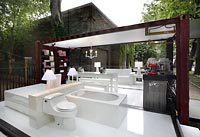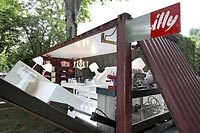This little six-room apartment is just as cute as a button

A push of a button that makes a compact shipping container pop open into a furnished and functional home? Only in science fiction?
No, it's practical fact, on terra firma among the art at the Venice Biennale, the Italian city's 52nd International Art Exhibition, running through November.
It's the Push Button House, sponsored by illycaffe, the Italian coffee company that's also a partner in the Biennale. The house is part of the rest area the company provides for Biennale visitors to sit, reflect on the art and have a cup of espresso.
The house is the work of American artist-architect Adam Kalkin, who built it from recyclable industrial materials. An earlier version had a preview at Art Basel/Miami Beach in 2005, and this is a first airing in Europe.
The house is powered by hydraulic cylinders controlled by a computer inside the kitchen island, Kalkin explained by e-mail. "When you push a button, the shipping container opens into a six-room apartment with a kitchen, dining room, bathroom, bedroom, living room and library."
As for its future: "The structure is a demonstration of concepts and mechanics that could be adapted to many different circumstances," he said. His company has developed projects ranging from disaster-relief housing systems to million-dollar houses and "exhibition spaces such as a little coffee utopia," he said. "People often approach us to make designs for unique applications."
It takes about 90 seconds for the house to pop open after the button is pressed — he could be fairly exact because he'd just demonstrated the process at a Biennale press conference, he said.
"Our plans for Push Button House are indefinite, but discussions range from placement in December at a premiere location in New York City to disaster relief or educational purposes in coffee-growing regions where illy sources its coffee," said Andrea Illy, chairman and CEO of illycaffe.
Illy undertook the project, he added, because, "We were interested in how the Push Button House expressed the idea of 'home,' and Adam Kalkin investigated for us the idea of home as one continuous moldable surface, a relief against which human activity would pop out."

